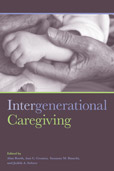| Time | to Add to Calendar 2006-10-05 00:00:00 2006-10-06 00:00:00 14th Annual Symposium on Family Issues - Intergenerational Caregiving Penn State University Population Research Institute America/New_York public |
|---|---|
| Location | Penn State University |
| Description |

Dramatic changes in American families over the past half century have transformed the nature of intergenerational relationships. Nuclear families have become smaller as fertility has declined, but extended families have become larger with gains in life expectancy leading to more multi-generational families. Divorce and non-marital childbearing, remarriage and cohabitation, all more common now than a half century ago, add further complexity to intergenerational relationships. They weaken ties to biological fathers while at the same time reinforcing some grandparent-grandchild ties. Step-children and step-grandchildren, increase the number of family members on whom an elderly person can potentially rely for help, but the strength of these familial ties may be insufficient to generate the desired care. These changing family ties also increase the importance of understanding how adult siblings, including step-siblings, negotiate intergenerational caregiving roles. Finally, women's greater employment also alters the "caregiving reserve" that families have and drives up the costs to women who forego employment to care for family members. In dual-earner families, the demands of two jobs create their own tensions, with men and women often having to negotiate, and renegotiate, how to divide housework, paid work and dependent care. In this symposium volume, scholars drawn from diverse disciplines consider factors that account for variation and change in relationships within and among generations, the strengths and weaknesses of existing information that can be used to understand change in inter- and intra-generational relationships, as well as implications for social policies. I. Intergenerational Ties: Contemporary Trends and ContextsThe goal of this section is to review what is known about intergenerational relationships (affective ties, caregiving, exchanges) and explain social, economic, demographic, and institutional contexts that impinge on those relationships. There is also a discussion of key questions that remain to be answered. Intergenerational Ties: Alternative Theories, Empirical Findings and Trends, and Remaining Challenges Are We Asking the Right Questions on Intergenerational Ties? Intergenerational Ties: What Can Be Gained from an International Comparative Perspective? Developing Interdisciplinary Approaches to Study Intergenerational Relationships II. Explaining Change and Variation in Intergenerational Caregiving and ExchangesThe focus of this section is on theoretical frameworks and models that have been proposed in economics and other fields to explain caregiving and exchanges. The section also includes emphasis on biological and evolutionary perspectives that inform theories of intergenerational exchange in the social sciences. Intergenerational Caregiving and Exchange: Economic and Evolutionary Approaches Do Bioevolutionary Forces Shape Intergenerational Transfers? Detecting Evidence in Contemporary Survey Data The Problem of Predictive Promiscuity in Deductive Applications of Evolutionary Reasoning to Intergenerational Transfers: Three Cautionary Tales Beyond Theory: Individual Differences in Exchanges Between Older Parents and Their Children III. The Nature of Negotiations within GenerationsThere is much less research on within-generation relationships than on intergenerational exchanges. Chapters in this section focus on innovative new investigations of adult sibling caregiving ties and the ways in which they are leading to new models of sibling interactions. Intergenerational Support, Care and Relationship Quality in Later Life: Exploring Within-Family Differences Unanticipated Lives: Inter- and Intra-generational Relationships in Families with Children with Disabilities Families as Non-shared Environments for Siblings Family Bargaining and Long-Term Care of the Disabled Elderly IV. Private and Public Provision in Care of Kin: Who Feels an Obligation for Whom?The chapters in this section focus on the types of kin ties that elicit feelings of private responsibility (exploring "degrees of removal" - biological ties, step-ties, in-laws, siblings, etc.) and how this varies across socioeconomic and racial groups. The implications for public support of within- and across-generation family caring and exchange will also be explored. The Distribution of Obligations Race and Ethnic Influences on Normative Beliefs and Attitudes toward Provision of Family Care Between the Motion and the Act: Psychological Perspectives on the Distribution of Obligations Interpreting Norms of Obligation as Planner's Preferences for Distributional Justice: A Formal Economic Model Expanding the Horizon: New Directions for the Study of Intergenerational Care and Exchange Book Citation Booth, Alan, Ann C. Crouter, Suzanne Bianchi, and Judith A. Seltzer (2008). Intergenerational Caregiving. Washington, D.C.: Urban The book is available from the Urban Institute Press (420 pages, ISBN 978-0-87766-747-6, $29.50). Order online at http://www.uipress.org, call 410-516-6956, or dial 1-800-537-5487 toll-free. More information is available at http://www.urban.org/books/intergenerationalcaregiving/. |
| Event URL | http://www.springer.com/gp/book/9783319015613 |
| Event Type |